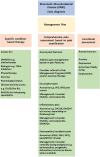Can we achieve pain stratification in musculoskeletal conditions? Implications for clinical practice
- PMID: 38524267
- PMCID: PMC10958789
- DOI: 10.3389/fpain.2024.1362757
Can we achieve pain stratification in musculoskeletal conditions? Implications for clinical practice
Abstract
In the last few years there has been an increased appreciation that pain perception in rheumatic and musculoskeletal diseases (RMDs) has several mechanisms which include nociceptive, inflammatory, nociplastic and neuropathic components. Studies in specific patient groups have also demonstrated that the pain experienced by people with specific diagnoses can present with distinctive components over time. For example, the pain observed in rheumatoid arthritis has been widely accepted to be caused by the activation of nociceptors, potentiated by the release of inflammatory mediators, including prostaglandins, leukotrienes and cytokine networks in the joint environment. However, people with RA may also experience nociplastic and neuropathic pain components, particularly when treatments with disease modifying anti-rheumatic drugs (DMARDs) have been implemented and are insufficient to control pain symptoms. In other RMDs, the concept of pain sensitisation or nociplastic pain in driving ongoing pain symptoms e.g. osteoarthritis and fibromyalgia, is becoming increasingly recognised. In this review, we explore the hypothesis that pain has distinct modalities based on clinical, pathophysiological, imaging and genetic factors. The concept of pain stratification in RMD is explored and implications for future management are also discussed.
Keywords: neuropathic pain; nociceptive pain; nociplastic pain; pain sensitisation; rheumatic and musculoskeletal diseases.
© 2024 Sofat and Lambarth.
Conflict of interest statement
The authors declare that the research was conducted in the absence of any commercial or financial relationships that could be construed as a potential conflict of interest.
Figures



References
-
- Price C. Putting pain on the agenda: the report of the First English Pain Summit. UK (2012). Available online at: https://www.britishpainsociety.org/static/uploads/resources/files/member... (accessed December 4, 2023).
Publication types
Grants and funding
LinkOut - more resources
Full Text Sources

